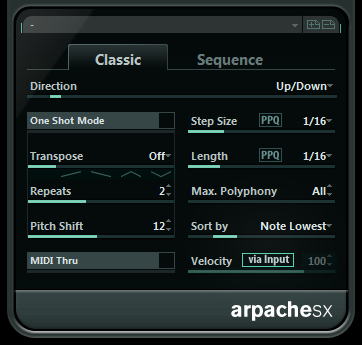Arpache SX
This is a versatile and advanced arpeggiator, capable of creating anything from traditional arpeggios to complex, sequencer-like patterns.
|
Cubase LE |
Cubase AI |
Cubase Elements |
Cubase Artist |
Cubase Pro |
Nuendo |
|
|---|---|---|---|---|---|---|
|
Included with |
– |
– |
– |
X |
X |
X |

Classic vs. Sequence Mode
Arpache SX has two different modes: Classic and Sequence. The Classic mode determines the basic behavior of Arpache SX. Sequence mode uses the events of an additional MIDI part as a pattern. This pattern forms the basis for the arpeggio, in conjunction with the MIDI input.
Classic Mode
- Direction
Allows you to choose how the notes in the played chord should be arpeggiated.
- One Shot Mode
Activate this option if you want the phrase to be played only once. If this option is deactivated, the phrase is looped.
- Transpose
With a setting other than Off, the arpeggio is expanded upwards, downwards, or both (depending on the mode). This is done by adding transposed repeats of the basic arpeggio pattern.
- Repeats
Sets the number of transposed repeats.
- Pitch Shift
Determines the transposition of each repeat.
- MIDI Thru
If this is activated, the played notes pass through the plug-in and are sent out together with the arpeggiated notes.
- Step Size
Determines the resolution of the arpeggio, that is, its speed (in fixed note values or PPQ, if the PPQ button is activated). In Sequence mode you can also activate the from sequence option.
- Length
Determines the length of the arpeggio notes (in fixed note values or PPQ, if the PPQ button is activated).
- Max. Polyphony
Determines how many notes should be accepted in the input chord. The All setting means there are no limitations.
- Sort by
If you play a chord, the arpeggiator sorts the notes in the chord in the order specified here. For example, if you play a C-E-G chord, with Note Lowest selected, C is the first note, E is the second and G the third. This affects the result of the Arp Style setting.
- Velocity
Determines the velocity of the notes in the arpeggio. Using the slider you can set a fixed velocity, or you can activate the via Input button to use the velocity values of the notes in the chord you play. In Sequence mode you can also activate the from sequence option.
Sequence Mode
In Sequence mode, you can import a MIDI part into Arpache SX by dragging it from the Project window onto the Drop MIDI Sequence field on the right of the Arpache SX panel.
The notes in the dropped MIDI part are sorted internally, either according to their pitch if the MIDI Seq. sort by pitch checkbox is activated or according to their play order in the part. This results in a list of numbers. For example, if the notes in the MIDI part are C E G A E C and they are sorted according to pitch, the list of numbers reads 1 2 3 4 2 1. Here, there are 4 different notes/numbers and 6 trigger positions.
The MIDI input (the chord you play) generates a list of numbers, with each note in the chord corresponding to a number depending on the Sort by setting.
Furthermore, the two lists of numbers are matched – Arpache SX tries to play back the pattern from the dropped MIDI part but using the notes from the MIDI input. The result depends on the Play Mode setting.
- Trigger
The whole pattern from the dropped MIDI file is played back, but transposed according to one of the notes in the MIDI input. Which note is used for transposing depends on the Sort by setting.
- Trigger Cnt.
As above, but even if all keys are released, the phrase continues playing from the last position (where it stopped), if a new key is pressed on the keyboard. This is typically used when playing live through the Arpache SX.
- Sort Normal
Matches the notes in the MIDI input with the notes in the dropped MIDI part. If there are fewer notes in the MIDI input, some steps in the resulting arpeggio remain empty.
- Sort First
As above, but if there are fewer notes in the MIDI input, the missing notes are replaced by the first note.
- Sort Any
As above, but if there are fewer notes in the MIDI input, the missing notes are replaced by random notes.
- Arp. Style
As above, but if there are fewer notes in the MIDI input, the missing notes are replaced by the last valid note in the arpeggio.
- Repeat
In this mode, the chords played are not separated into notes. Instead, they are used as is, and only the rhythm of the dropped MIDI part is used for playback.
You can choose to keep the original note timing, note length, and note velocities from the dropped MIDI part, by selecting from sequence for the Step Size, Length, and Velocity options.